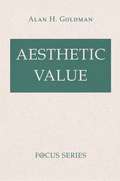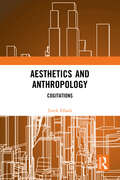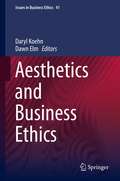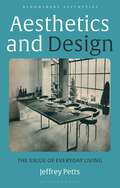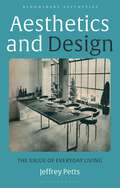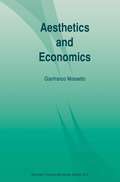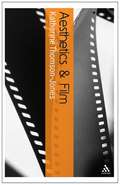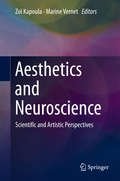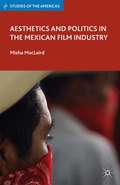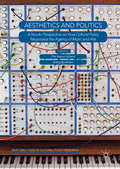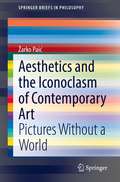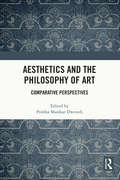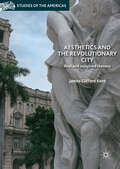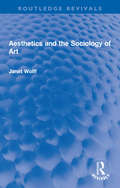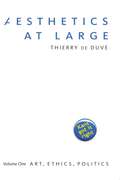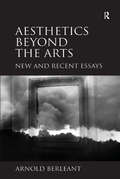- Table View
- List View
Aesthetic Value (PDF)
by Alan GoldmanAt the heart of aesthetics lie fundamental questions about value in art and the objectivity of aesthetic valuation. A theory of aesthetic value must explain how the properties of artworks contribute to the values derived from contemplating and appreciating works of art. When someone passes judgment on a work of art, just what is it that is happening, and how can such judgments be criticized and defended?In this concise survey, intended for advanced undergraduate students of aesthetics, Alan Goldman focuses on the question of aesthetic value, using many practical examples from painting, music, and literature to make his case. Although he treats a wide variety of views, he argues for a non realist view of aesthetic value, showing that the personal element can never be factored out of evaluative aesthetic judgments and explaining why this is so. At the same time, he argues for certain common effects of highly esteemed artworks. Along the way Goldman considers such key topics as interpretation, representation, expression, and taste. His text will be a valuable contribution to the teaching of aesthetics as well as to the understanding of these topics.
Aesthetics and Anthropology: Cogitations
by Tarek ElhaikThis book focuses on the reconfiguration of aesthetic anthropology into an anthropological problem of cogitation, opening up a fascinating new dialogue between the domains of anthropology, philosophy, and art. Tarek Elhaik embarks on an inquiry composed of a series of cogitations based on fieldwork in an ecology of artistic and scientific practices: from conceptual art exhibitions to architectural environments; from photographic montages to the videotaping of spirit seances; from artistic interventions in natural history museums to ongoing dialogues between performance artists and marine scientists. The chapters examine the image-work, ethical demands, and aesthetic struggles of interlocutors including artists Mathias Goeritz, Mounir Fatmi, Silvia Gruner, Joan Jonas, and Patricia Lagarde.
Aesthetics and Anthropology: Cogitations
by Tarek ElhaikThis book focuses on the reconfiguration of aesthetic anthropology into an anthropological problem of cogitation, opening up a fascinating new dialogue between the domains of anthropology, philosophy, and art. Tarek Elhaik embarks on an inquiry composed of a series of cogitations based on fieldwork in an ecology of artistic and scientific practices: from conceptual art exhibitions to architectural environments; from photographic montages to the videotaping of spirit seances; from artistic interventions in natural history museums to ongoing dialogues between performance artists and marine scientists. The chapters examine the image-work, ethical demands, and aesthetic struggles of interlocutors including artists Mathias Goeritz, Mounir Fatmi, Silvia Gruner, Joan Jonas, and Patricia Lagarde.
Aesthetics and Business Ethics (Issues in Business Ethics #41)
by Daryl Koehn Dawn ElmLudwig Wittgenstein famously said, “Ethics is aesthetics.” It is unclear what such a claim might mean and whether it is true. This book explores contentious issues arising at the interface of ethics and aesthetics. The contributions reflect on the status of aesthetic en ethical judgments, the relation of aesthetic beauty and ethical goodness and art and character development. The book further considers the potential role art could play in ethical analysis and in the classroom and explores in what respects aesthetics and ethics might be intertwined and even mutually supportive.
Aesthetics and Design: The Value of Everyday Living (Bloomsbury Aesthetics)
by Jeffrey PettsWhat designers do and how we all, as users of designed things, live with their products raises fundamental philosophical questions about how we should live, and how the nature of design work and good design relates to our lives.Jeffrey Petts presents a holistic and pragmatist approach to the philosophy of design. Acknowledging the importance of function in design without downplaying the aesthetic dimension, Petts relates the manner of evaluating design to the designing process itself as demonstrated in the work of, for example, William Morris, Walter Gropius and Bauhaus, Charles and Ray Eames, and Dieter Rams. This metacritical and everyday approach to the philosophy of design expresses a commitment to real aesthetics, connecting concrete issues in both practice and experience to philosophical ideas, and reveals the role aesthetics plays in considerations about the good life.
Aesthetics and Design: The Value of Everyday Living (Bloomsbury Aesthetics)
by Jeffrey PettsWhat designers do and how we all, as users of designed things, live with their products raises fundamental philosophical questions about how we should live, and how the nature of design work and good design relates to our lives.Jeffrey Petts presents a holistic and pragmatist approach to the philosophy of design. Acknowledging the importance of function in design without downplaying the aesthetic dimension, Petts relates the manner of evaluating design to the designing process itself as demonstrated in the work of, for example, William Morris, Walter Gropius and Bauhaus, Charles and Ray Eames, and Dieter Rams. This metacritical and everyday approach to the philosophy of design expresses a commitment to real aesthetics, connecting concrete issues in both practice and experience to philosophical ideas, and reveals the role aesthetics plays in considerations about the good life.
Aesthetics and Economics
by Gianfranco MossettoAesthetics and Economics is a pioneering effort at treating aesthetics from the point of view of economic theory, and addresses the contradictions which have arisen from economists' work in this field over the years. Starting from an historical review of the treatment of aesthetics in economic thought, Aesthetics and Economics goes through the integration of a number of recent advances in economic thinking with the main topics of aesthetics, from creativity to interpretation. The subject is systematically treated on the grounds of a restatement of the optimization analysis on non-consequentialist bases, starting from the Kantian definition of aesthetic judgement up to its contemporary developments. A specific information asymmetry characterizing the agents' behaviours arises from the aesthetic qualification of consumption, production and investment processes, thus affecting the usual equilibrium and optimization conditions, resulting in new institutional interventions in the market. `Certification' of the aesthetic nature of goods and stocks is needed and gives place to original market strategies and optimization problems.
Aesthetics and Film (Bloomsbury Aesthetics)
by Katherine Thomson-JonesAesthetics and Film is a philosophical study of the art of film. Its motivation is the recent surge of interest among analytic philosophers in the philosophical implications of central issues in film theory and the application of general issues in aesthetics to the specific case of film. Of particular interest are questions concerning the distinctive representational capacities of film art, particularly in relation to realism and narration, the influence of the literary paradigm in understanding film authorship and interpretation, and our imaginative and affective engagement with film. For all of these questions, Katherine Thomson-Jones critically compares the most compelling answers, driving home key points with a wide range of film examples including Wiene's The Cabinet of Doctor Caligari, Eisenstein's October, Hitchcock's Rear Window, Kubrick's The Shining and Sluizer's The Vanishing. Students and scholars of aesthetics and cinema will find this an illuminating, accessible and highly enjoyable investigation into the nature and power of a technologically evolving art form.
Aesthetics and Film (Bloomsbury Aesthetics)
by Katherine Thomson-JonesAesthetics and Film is a philosophical study of the art of film. Its motivation is the recent surge of interest among analytic philosophers in the philosophical implications of central issues in film theory and the application of general issues in aesthetics to the specific case of film. Of particular interest are questions concerning the distinctive representational capacities of film art, particularly in relation to realism and narration, the influence of the literary paradigm in understanding film authorship and interpretation, and our imaginative and affective engagement with film. For all of these questions, Katherine Thomson-Jones critically compares the most compelling answers, driving home key points with a wide range of film examples including Wiene's The Cabinet of Doctor Caligari, Eisenstein's October, Hitchcock's Rear Window, Kubrick's The Shining and Sluizer's The Vanishing. Students and scholars of aesthetics and cinema will find this an illuminating, accessible and highly enjoyable investigation into the nature and power of a technologically evolving art form.
Aesthetics and Neuroscience: Scientific and Artistic Perspectives
by Zoï Kapoula Marine VernetThis edited monograph provides a compelling analysis of the interplay between neuroscience and aesthetics. The book broaches a wide spectrum of topics including, but not limited to, mathematics and creator algorithms, neurosciences of artistic creativity, paintings and dynamical systems as well as computational research for architecture. The international authorship is genuinely interdisciplinary and the target audience primarily comprises readers interested in transdisciplinary research between neuroscience and the broad field of aesthetics.
Aesthetics and Politics in the Mexican Film Industry (Studies of the Americas)
by M. MacLairdEvaluating a broad selection of Mexican films produced from the early 1990s to the present, this study examines how production methods, audience demographics, and aesthetic approaches have changed throughout the past two decades and how these changes relate to the country's transitions to a democratic political system and a free-market economy.
Aesthetics and Politics (PDF)
by Ole Marius Hylland Erling BjurströmThrough comparative and integrated case studies, this book demonstrates how aesthetics becomes politics in cultural policy. Contributors from Norway, Sweden and the UK analyse exactly what happens when art is considered relevant for societal development, at both a practical and theoretical level. Cultural policy is seen here as a mechanism for translating values, that through organized and practical aesthetical judgement lend different forms of agency to the arts. What happens when aesthetical value is reinterpreted as political value? What kinds of negotiations take place at a cultural policy ground level when values are translated and reinterpreted? By addressing these questions, the editors present an original collection that effectively centralises and investigates the role of aesthetics in cultural policy research.
Aesthetics and the Iconoclasm of Contemporary Art: Pictures Without a World (SpringerBriefs in Philosophy)
by Žarko PaićThe main themes and aims of this book are understanding aesthetics, contemporary art and the end of the avant-garde not from the traditional viewpoint of the metaphysics of the beautiful and the sublime but rather thru close connection to the techno-genesis of virtual worlds. This book tackles problems in contemporary art theory such as the body in space and time of digital technologies, along with other issues in visual studies and image science. Further intentions exhibit the fundamental reasons for the disappearance of the picture in the era of virtual reality starting from the notion of contemporary art as realized iconoclasm; art has no world for its "image". The author argues that the iconoclasm of contemporary art has severe consequences. This text appeals to philosophers of art and those interested in contemporary art theory.
Aesthetics and the Philosophy of Art: Comparative Perspectives
by Prabha Shankar DwivediThis volume brings together the finest research on aesthetics and the philosophy of art by stalwart critics and leading scholars in the field. It discusses various themes, such as the idea of aesthetic perception, the nature of aesthetic experience, attitude theory, the relation of art to morality, representation in art, and the association of aesthetics with language studies in the Indian tradition. It deliberates over the theories and views of Aristotle, Freud, Plato, Immanuel Kant, T. S. Eliot, George Dickie, Leo Tolstoy, R. G. Collingwood, Michael H. Mitias, Monroe C. Beardsley, and Abhinavagupta, among others. The book offers a comparative perspective on Indian and Western approaches to the study of art and aesthetics and enables readers to appreciate the similarities and differences between the conceptions of aesthetics and philosophy of art on a comparative scale detailing various aspects of both. The first of its kind, this key text will be useful for scholars and researchers of arts and aesthetics, philosophy of art, cultural studies, comparative literature, and philosophy in general. It will also appeal to general readers interested in the philosophy of art.
Aesthetics and the Philosophy of Art: Comparative Perspectives
by Prabha Shankar DwivediThis volume brings together the finest research on aesthetics and the philosophy of art by stalwart critics and leading scholars in the field. It discusses various themes, such as the idea of aesthetic perception, the nature of aesthetic experience, attitude theory, the relation of art to morality, representation in art, and the association of aesthetics with language studies in the Indian tradition. It deliberates over the theories and views of Aristotle, Freud, Plato, Immanuel Kant, T. S. Eliot, George Dickie, Leo Tolstoy, R. G. Collingwood, Michael H. Mitias, Monroe C. Beardsley, and Abhinavagupta, among others. The book offers a comparative perspective on Indian and Western approaches to the study of art and aesthetics and enables readers to appreciate the similarities and differences between the conceptions of aesthetics and philosophy of art on a comparative scale detailing various aspects of both. The first of its kind, this key text will be useful for scholars and researchers of arts and aesthetics, philosophy of art, cultural studies, comparative literature, and philosophy in general. It will also appeal to general readers interested in the philosophy of art.
Aesthetics and the Revolutionary City: Real and Imagined Havana (Studies of the Americas)
by James Clifford KentAesthetics and the Revolutionary City engages in alternative ways of reading foreign visual representations of Havana through analysis of advertising images, documentary films, and photographic texts. It explores key narratives relating to the projection of different Havana imaginaries and focuses on a range of themes including: pre-revolutionary Cuba; the dream of revolution; and the metaphor of the city “frozen-in-time.” The book also synthesizes contemporary debates regarding the notion of Havana as a real and imagined city space and fleshes out its theoretical insights with a series of stand-alone, important case studies linked to the representation of the Cuban capital in the Western imaginary. The interpretations in the book bring into focus a range of critical historical moments in Cuban history (including the Cuban Revolution and the “Special Period”) and consider the ways in which they have been projected in advertising, documentary film and photography outside the island.
Aesthetics and the Sociology of Art (Routledge Revivals)
by Janet WolffFirst published in 1983, Aesthetics and the Sociology of Art provides a lucid account of two divergent tendencies in the study of aesthetics. At the one extreme, traditional aestheticians have assumed that art and literature are wholly independent, following only the laws and inspirations of artists and artistic movements, and that the question of aesthetic value is accordingly unproblematic. At the other extreme, some sociologists have treated works of art as no more than manifestations of the socio-economic circumstances which produce them, arguing that aesthetic value is therefore entirely relative matter. Janet Wolff shows how both the extreme positions are untenable, and argues convincingly that we must accept that the conceptions and criteria of aesthetic value are socially constructed and inevitably ideological, while stopping short of the reductionist alternative which fails to recognise the irreducible questions of pleasure and of aesthetic discourse. This book provides an invaluably clear guide both to old debates and to otherwise obscure modern controversies, which will be welcomed both by students and scholars in the sociology of art, in aesthetics, in art history, and in literary criticism.
Aesthetics and the Sociology of Art (Routledge Revivals)
by Janet WolffFirst published in 1983, Aesthetics and the Sociology of Art provides a lucid account of two divergent tendencies in the study of aesthetics. At the one extreme, traditional aestheticians have assumed that art and literature are wholly independent, following only the laws and inspirations of artists and artistic movements, and that the question of aesthetic value is accordingly unproblematic. At the other extreme, some sociologists have treated works of art as no more than manifestations of the socio-economic circumstances which produce them, arguing that aesthetic value is therefore entirely relative matter. Janet Wolff shows how both the extreme positions are untenable, and argues convincingly that we must accept that the conceptions and criteria of aesthetic value are socially constructed and inevitably ideological, while stopping short of the reductionist alternative which fails to recognise the irreducible questions of pleasure and of aesthetic discourse. This book provides an invaluably clear guide both to old debates and to otherwise obscure modern controversies, which will be welcomed both by students and scholars in the sociology of art, in aesthetics, in art history, and in literary criticism.
Aesthetics at Large: Volume 1: Art, Ethics, Politics
by Thierry de DuveImmanuel Kant’s Critique of Judgment, Thierry de Duve argues in the first volume of Aesthetics at Large, is as relevant to the appreciation of art today as it was to the enjoyment of beautiful nature in 1790. Going against the grain of all aesthetic theories situated in the Hegelian tradition, this provocative thesis, which already guided de Duve’s groundbreaking book Kant After Duchamp (1996), is here pursued in order to demonstrate that far from confining aesthetics to a stifling formalism isolated from all worldly concerns, Kant’s guidance urgently opens the understanding of art onto ethics and politics. Central to de Duve’s re-reading of the Critique of Judgment is Kant’s idea of sensus communis, ultimately interpreted as the mere yet necessary idea that human beings are capable of living in peace with one another. De Duve pushes Kant’s skepticism to its limits by submitting the idea of sensus communis to various tests leading to questions such as: Do artists speak on behalf of all of us? Is art the transcendental ground of democracy? Or, Was Adorno right when he claimed that no poetry could be written after Auschwitz? Loaded with de Duve’s trademark blend of wit and erudition and written without jargon, these essays radically renew current approaches to some of the most burning issues raised by modern and contemporary art. They are indispensable reading for anyone with a deep interest in art, art history, or philosophical aesthetics.
Aesthetics at Large: Volume 1: Art, Ethics, Politics
by Thierry de DuveImmanuel Kant’s Critique of Judgment, Thierry de Duve argues in the first volume of Aesthetics at Large, is as relevant to the appreciation of art today as it was to the enjoyment of beautiful nature in 1790. Going against the grain of all aesthetic theories situated in the Hegelian tradition, this provocative thesis, which already guided de Duve’s groundbreaking book Kant After Duchamp (1996), is here pursued in order to demonstrate that far from confining aesthetics to a stifling formalism isolated from all worldly concerns, Kant’s guidance urgently opens the understanding of art onto ethics and politics. Central to de Duve’s re-reading of the Critique of Judgment is Kant’s idea of sensus communis, ultimately interpreted as the mere yet necessary idea that human beings are capable of living in peace with one another. De Duve pushes Kant’s skepticism to its limits by submitting the idea of sensus communis to various tests leading to questions such as: Do artists speak on behalf of all of us? Is art the transcendental ground of democracy? Or, Was Adorno right when he claimed that no poetry could be written after Auschwitz? Loaded with de Duve’s trademark blend of wit and erudition and written without jargon, these essays radically renew current approaches to some of the most burning issues raised by modern and contemporary art. They are indispensable reading for anyone with a deep interest in art, art history, or philosophical aesthetics.
Aesthetics at Large: Volume 1: Art, Ethics, Politics
by Thierry de DuveImmanuel Kant’s Critique of Judgment, Thierry de Duve argues in the first volume of Aesthetics at Large, is as relevant to the appreciation of art today as it was to the enjoyment of beautiful nature in 1790. Going against the grain of all aesthetic theories situated in the Hegelian tradition, this provocative thesis, which already guided de Duve’s groundbreaking book Kant After Duchamp (1996), is here pursued in order to demonstrate that far from confining aesthetics to a stifling formalism isolated from all worldly concerns, Kant’s guidance urgently opens the understanding of art onto ethics and politics. Central to de Duve’s re-reading of the Critique of Judgment is Kant’s idea of sensus communis, ultimately interpreted as the mere yet necessary idea that human beings are capable of living in peace with one another. De Duve pushes Kant’s skepticism to its limits by submitting the idea of sensus communis to various tests leading to questions such as: Do artists speak on behalf of all of us? Is art the transcendental ground of democracy? Or, Was Adorno right when he claimed that no poetry could be written after Auschwitz? Loaded with de Duve’s trademark blend of wit and erudition and written without jargon, these essays radically renew current approaches to some of the most burning issues raised by modern and contemporary art. They are indispensable reading for anyone with a deep interest in art, art history, or philosophical aesthetics.
Aesthetics at Large: Volume 1: Art, Ethics, Politics
by Thierry de DuveImmanuel Kant’s Critique of Judgment, Thierry de Duve argues in the first volume of Aesthetics at Large, is as relevant to the appreciation of art today as it was to the enjoyment of beautiful nature in 1790. Going against the grain of all aesthetic theories situated in the Hegelian tradition, this provocative thesis, which already guided de Duve’s groundbreaking book Kant After Duchamp (1996), is here pursued in order to demonstrate that far from confining aesthetics to a stifling formalism isolated from all worldly concerns, Kant’s guidance urgently opens the understanding of art onto ethics and politics. Central to de Duve’s re-reading of the Critique of Judgment is Kant’s idea of sensus communis, ultimately interpreted as the mere yet necessary idea that human beings are capable of living in peace with one another. De Duve pushes Kant’s skepticism to its limits by submitting the idea of sensus communis to various tests leading to questions such as: Do artists speak on behalf of all of us? Is art the transcendental ground of democracy? Or, Was Adorno right when he claimed that no poetry could be written after Auschwitz? Loaded with de Duve’s trademark blend of wit and erudition and written without jargon, these essays radically renew current approaches to some of the most burning issues raised by modern and contemporary art. They are indispensable reading for anyone with a deep interest in art, art history, or philosophical aesthetics.
Aesthetics at Large: Volume 1: Art, Ethics, Politics
by Thierry de DuveImmanuel Kant’s Critique of Judgment, Thierry de Duve argues in the first volume of Aesthetics at Large, is as relevant to the appreciation of art today as it was to the enjoyment of beautiful nature in 1790. Going against the grain of all aesthetic theories situated in the Hegelian tradition, this provocative thesis, which already guided de Duve’s groundbreaking book Kant After Duchamp (1996), is here pursued in order to demonstrate that far from confining aesthetics to a stifling formalism isolated from all worldly concerns, Kant’s guidance urgently opens the understanding of art onto ethics and politics. Central to de Duve’s re-reading of the Critique of Judgment is Kant’s idea of sensus communis, ultimately interpreted as the mere yet necessary idea that human beings are capable of living in peace with one another. De Duve pushes Kant’s skepticism to its limits by submitting the idea of sensus communis to various tests leading to questions such as: Do artists speak on behalf of all of us? Is art the transcendental ground of democracy? Or, Was Adorno right when he claimed that no poetry could be written after Auschwitz? Loaded with de Duve’s trademark blend of wit and erudition and written without jargon, these essays radically renew current approaches to some of the most burning issues raised by modern and contemporary art. They are indispensable reading for anyone with a deep interest in art, art history, or philosophical aesthetics.
Aesthetics at Large: Volume 1: Art, Ethics, Politics
by Thierry de DuveImmanuel Kant’s Critique of Judgment, Thierry de Duve argues in the first volume of Aesthetics at Large, is as relevant to the appreciation of art today as it was to the enjoyment of beautiful nature in 1790. Going against the grain of all aesthetic theories situated in the Hegelian tradition, this provocative thesis, which already guided de Duve’s groundbreaking book Kant After Duchamp (1996), is here pursued in order to demonstrate that far from confining aesthetics to a stifling formalism isolated from all worldly concerns, Kant’s guidance urgently opens the understanding of art onto ethics and politics. Central to de Duve’s re-reading of the Critique of Judgment is Kant’s idea of sensus communis, ultimately interpreted as the mere yet necessary idea that human beings are capable of living in peace with one another. De Duve pushes Kant’s skepticism to its limits by submitting the idea of sensus communis to various tests leading to questions such as: Do artists speak on behalf of all of us? Is art the transcendental ground of democracy? Or, Was Adorno right when he claimed that no poetry could be written after Auschwitz? Loaded with de Duve’s trademark blend of wit and erudition and written without jargon, these essays radically renew current approaches to some of the most burning issues raised by modern and contemporary art. They are indispensable reading for anyone with a deep interest in art, art history, or philosophical aesthetics.
Aesthetics beyond the Arts: New and Recent Essays
by Arnold BerleantTaking the view that aesthetics is a study grounded in perception, the essays in this volume exhibit many sides of the perceptual complex that is the aesthetic field and develop them in different ways. They reinvigorate our understanding of such arts as music and architecture; they range across the natural landscape to the urban one; they reassess the place of beauty in the modern environment and reassess the significance of the contributions to aesthetic theory of Kant and Dewey; and they broach the kinds of meanings and larger understanding that aesthetic engagement with the human environment can offer. Written over the past decade, these original and innovative essays lead to a fresh encounter with the possibilities of aesthetic experience, one which has constantly evolved, moving in recent years in the direction of what Berleant terms 'social aesthetics', which enhances human-environmental integration and sociality.
